
Artificial intelligence and wearable technology can help companies better understand the risk profile of their workforce and provide bespoke injury prevention training where needed, according to a workplace safety expert.
Andrew McColl, occupational health and safety specialist at Preventure, a provider of wearable technology and AI-powered smartphone training packages, said wearables, which have long been used in elite sports, are now finding their way into workplaces to automate the delivery of safety alerts and virtual safety training to employees.
“Until recently, the only way that safety professionals could manage the risks associated with musculoskeletal injuries was through subjective, option-based assessments and one-size-fits-all manual handling training programs,” McColl said.
Safe Work Australia’s 2020-21 Australian worker’s compensation statistics report revealed that 40 per cent of all serious claims were for traumatic joint/ligament and muscle/tendon injuries.
In 2021, the median time lost for a serious claim was seven working weeks, which reflects a 67 per cent increase from four weeks in 2001.
Innovative workplace safety technology can minimise risk exposure and promote staff well-being, particularly in the manufacturing, construction, and logistics industries.
“Along with providing a range of safety enhancements, wearables and AI technology can help employers set benchmarks for pre-employment screening, as well as standards for workers returning from injury,” McColl said.
Preventative technology also goes beyond reducing the risk of workplace injuries and helps minimise issues that arise from unhealthy work practices, such as bad posture and lack of exercise.
In a media release, McColl highlighted some of the benefits of wearable AI technology for workplace safety management. These include promoting fatigue prevention and providing tailored training.
It can also serve as a cost-effective solution for organisations that seek to build a program suited to the specific needs and requirements of their operations.
“By using wearables and AI in the workplace, businesses can prevent workplace injuries and ensure that employees adhere to manual handling policies, while also delivering an innovative, personalised approach to health and safety,” McColl said.
The Preventure safety specialist is slated to join the Workplace Health and Safety Show’s Spotlight Stage lineup on 20 September.
McColl’s presentation, titled Return-To-Work via Wearable Sensors and an AI-Powered Education Platform, will explore how wearable technology is being used in workplaces across Australia, particularly in a return-to-work setting.




















